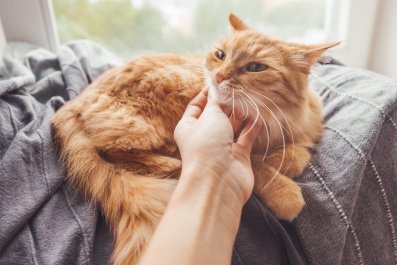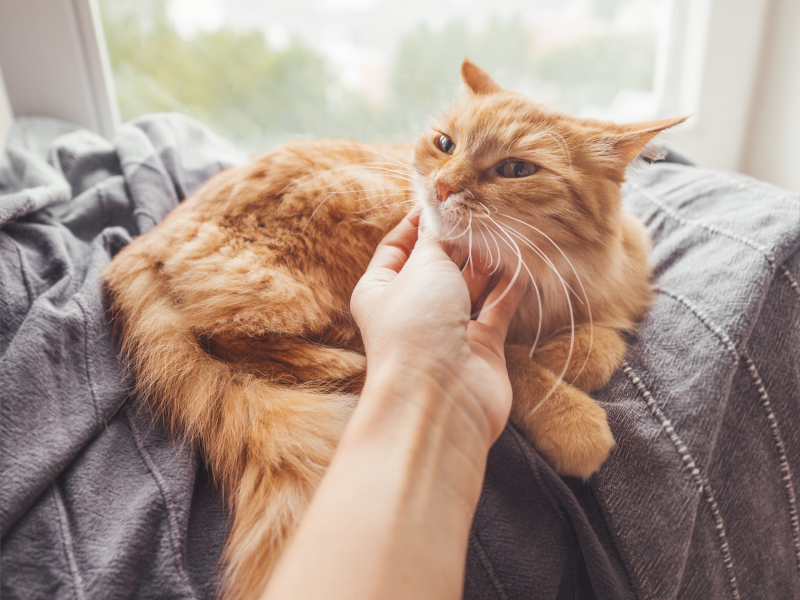
Owner Spots Cat's 'Airplane Ears,' Fails to Stop the Inevitable
A video of a cat that persistently tries to bite his owner's arm has gone viral on TikTok.
The clip posted by @biscuit_the_catbear, the TikTok account of a cat called Biscuit, features the feline's intense expressions and stubborn behavior while highlighting the playful yet unpredictable nature of many pet cats. The video has amassed over 837,000 views since it was posted on August 7.
In the clip, Biscuit is seen lying on a bed next to his owner, initially attempting to nibble on her arm. As the cat clings to the arm with both paws, his owner sternly says, "Biscuit, get off, no." But instead of heeding the warning, the cat stares intently at the arm, as if contemplating his next move.
@biscuit_the_catbear Itâs so hard to tell him off when heâs so funny ð #orangecat
⬠original sound - Biscuit bear
Despite the owner's continued protests, including a firm "Stop it. No," Biscuit remains fixated. The owner later says, "Put those airplane ears away," referring to a cat's backward-tilted ears—a common sign that it is preparing to pounce or react.
Eventually, Biscuit gives in momentarily, leaning back before making another attempt. "Don't do it," the owner warns, but Biscuit cheekily face-plants into the arm again, showing his playful defiance.
The comedic struggle between the two continues as the owner tries to push the cat away. At one point, as Biscuit tries to bite again, she says, "Enough...you're choking yourself" while holding the cat gently by the neck to deter him.
A caption shared with the post reads: "It's so hard to tell him off when he's so funny."
Why Do Cats Bite?
In a March article for PetMD, veterinarian Alison Gerken said that some cats give "love bites" as a sign of affection and that there are various reasons behind this behavior.
"There isn't a straightforward answer to why cats give love bites. As the term implies, some cats give them as a sign of affection or bonding, expressing their fondness for their human companions," Gerken said. However, cats might engage in this biting behavior because of overstimulation, frustration or even as part of their innate predatory instincts.
Understanding a cat's body language, and the context in which these interactions occur, is key to decoding their behavior. For example, a cat may lightly bite to signal that it wants to end a petting session. Or it might be asking for more attention.

In Biscuit's case in the viral clip, his play behavior and intense gaze could easily be a combination of both playful affection and a display of his natural predatory tendencies.
Gerken wrote, "Understanding the rest of the cat's body language and the context in which the love bite occurs is essential for knowing the motivation behind each bite."
'Madness in the Eyes'
TikTok users were amused by Biscuit's antics, such as Lina, who commented on "the way he charged up to attack again."
Monica Camal wrote: "The stance—double chin, airplane ears, and madness in the eyes—CHARGEEEEE," humorously describing the cat's intense body language.
Tracybarwell1975 also pointed out Biscuit's "mad eyeballs," while user @rachsgarden said, "The ears and the eyes... you know they gonna pounce."
Another TikToker, user6640339606127, hilariously said: "The way he activated when you said to put the airplane ears away lol."
Newsweek has contacted the original poster for comment via TikTok. The video has not been independently verified.
Do you have funny and adorable videos or pictures of your pet you want to share? Send them to life@newsweek.com with some details about your best friend and they could appear in our Pet of the Week lineup.
